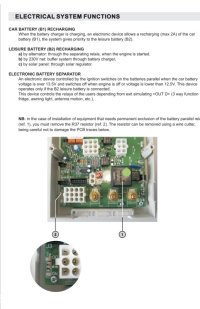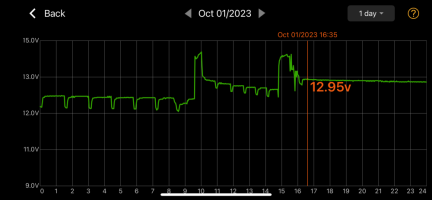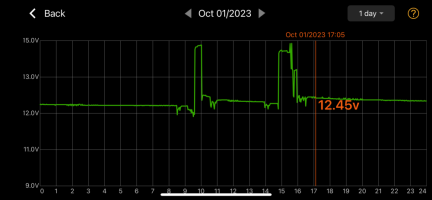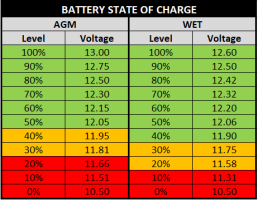You don't need a connection to the van battery at all if you are using a separate DC DC charger.Hi All,
I’m still trying to get my head around the installation of the CBE210 ? I’ve just purchased the full kit, my question is do you have to run a cable to the engine battery B1 & do you have to run the cable to the ignition, can you get away without them ie will it still work ?
You are using an out of date browser. It may not display this or other websites correctly.
You should upgrade or use an alternative browser.
You should upgrade or use an alternative browser.
CBE PC210 Power Management
Good morning all,
Sorry to bring this post alive again but I've looked back at this multiple times over the past 2 weeks when deciding what I'm doing with my electrics. Very good and informative but I have a couple of questions if somebody could assist.
For my set up I plan to go with the following;
- Sterling BBS1230 for the B2B charger and also the solar input.
- CBE PC210 kit (I really like the control panel LED interface, I think it'll look good within the van)
Reading the CBE PC210 manual and the posts within this thread I am going to connect vehicle battery to B1 via a 6mm fused cable so I can see the voltage information on the display for the vehicle battery. Second to that I am also going to connect the leisure battery to B2 via a 6mm fused cable so I can see the leisure battery voltages etc.
Question no.1.... When out in the van and 'NOT' on EHU and the van ignition is off will the CBE PC210 draw small amounts of current from the vehicle battery as I have it connected to view the voltage output, thus slowly draining it over time. OR... Does it take it power to turn on from connection B2, meaning it powers off of the leisure battery.
I plan to remove the resistor mounted within the kit to disable to split charge system.
Anyone in the thread that has this kit installed willing to pass experience and review on the kit?
I understand my set up is on the expensive side comparing to other ways of doing the electrics but I like the interface from the CBE and also don't want a split charge relay for my vehicle to leisure battery charging - want something more robust and future proof.
NOTE: I have a T5.1 2015
Sorry to bring this post alive again but I've looked back at this multiple times over the past 2 weeks when deciding what I'm doing with my electrics. Very good and informative but I have a couple of questions if somebody could assist.
For my set up I plan to go with the following;
- Sterling BBS1230 for the B2B charger and also the solar input.
- CBE PC210 kit (I really like the control panel LED interface, I think it'll look good within the van)
Reading the CBE PC210 manual and the posts within this thread I am going to connect vehicle battery to B1 via a 6mm fused cable so I can see the voltage information on the display for the vehicle battery. Second to that I am also going to connect the leisure battery to B2 via a 6mm fused cable so I can see the leisure battery voltages etc.
Question no.1.... When out in the van and 'NOT' on EHU and the van ignition is off will the CBE PC210 draw small amounts of current from the vehicle battery as I have it connected to view the voltage output, thus slowly draining it over time. OR... Does it take it power to turn on from connection B2, meaning it powers off of the leisure battery.
I plan to remove the resistor mounted within the kit to disable to split charge system.
Anyone in the thread that has this kit installed willing to pass experience and review on the kit?
I understand my set up is on the expensive side comparing to other ways of doing the electrics but I like the interface from the CBE and also don't want a split charge relay for my vehicle to leisure battery charging - want something more robust and future proof.
NOTE: I have a T5.1 2015
steveetheteevee
New Member
hi thereGood morning all,
Sorry to bring this post alive again but I've looked back at this multiple times over the past 2 weeks when deciding what I'm doing with my electrics. Very good and informative but I have a couple of questions if somebody could assist.
For my set up I plan to go with the following;
- Sterling BBS1230 for the B2B charger and also the solar input.
- CBE PC210 kit (I really like the control panel LED interface, I think it'll look good within the van)
Reading the CBE PC210 manual and the posts within this thread I am going to connect vehicle battery to B1 via a 6mm fused cable so I can see the voltage information on the display for the vehicle battery. Second to that I am also going to connect the leisure battery to B2 via a 6mm fused cable so I can see the leisure battery voltages etc.
Question no.1.... When out in the van and 'NOT' on EHU and the van ignition is off will the CBE PC210 draw small amounts of current from the vehicle battery as I have it connected to view the voltage output, thus slowly draining it over time. OR... Does it take it power to turn on from connection B2, meaning it powers off of the leisure battery.
I plan to remove the resistor mounted within the kit to disable to split charge system.
Anyone in the thread that has this kit installed willing to pass experience and review on the kit?
I understand my set up is on the expensive side comparing to other ways of doing the electrics but I like the interface from the CBE and also don't want a split charge relay for my vehicle to leisure battery charging - want something more robust and future proof.
NOTE: I have a T5.1 2015
just wondered how you got with this I have just fitted the same in my t6 but with a couple of small issues managed to get everything working apart from I cannot get the 230v to charge the leisure batteries it says its plugged in on the pc210 but charge is no rising wondered if you had any clues or tips
Hi,hi there
just wondered how you got with this I have just fitted the same in my t6 but with a couple of small issues managed to get everything working apart from I cannot get the 230v to charge the leisure batteries it says its plugged in on the pc210 but charge is no rising wondered if you had any clues or tips
Sorry I cannot help unfortunately. I didn't go this route in the end with my set up. I went with a full Victron.
Got some pics?
Hi all! Appreciate this is an old thread but it fits pretty well to my problem. Hope someone can help. I'm not really knowledgable in this area and I have a converted van that has the CBE PC210 kit in it.
1) I've read about issues with a split charge relay and start/stop engines... does anyone know if the CB516 in the kit is a split charge relay or a battery to battery charger?
2) I've read about "parallelling" and I'm not sure what it is... and there's this resistor that many people seem to be removing but to me it sounds like this stops the PC210 charging the van battery when on EHU ... but this sounds like a good thing to me, I don't know why it would need to be removed
Any advice appreciated. I feel I've got a lot to learn here and the CBE manuals are pretty poor!
Thanks, Dan
1) I've read about issues with a split charge relay and start/stop engines... does anyone know if the CB516 in the kit is a split charge relay or a battery to battery charger?
2) I've read about "parallelling" and I'm not sure what it is... and there's this resistor that many people seem to be removing but to me it sounds like this stops the PC210 charging the van battery when on EHU ... but this sounds like a good thing to me, I don't know why it would need to be removed
Any advice appreciated. I feel I've got a lot to learn here and the CBE manuals are pretty poor!
Thanks, Dan
I've found a copy of the manual here:
The section you seem to be talking about is this one and I agree the manual seems to suffer from being not very well translated from the (presumably) original Italian

If this is your only equipment then this is a split charge relay (reference 1) and is what they mean by "parallel" because such a relay will connect both batteries in parallel.
That will generally lead to mediocre charging in stop/start vehicles and you'd expect both batteries to only reach a maximum charger of around 80% from the alternator.
Removing the resistor would disable the built in split charge relay, not the EHU charger. You would do this if fitting a better external DC-DC charger to charge your leisure battery from the alternator but wanted to retain the rest of the system for EHU and 12v distribution.
The all in one systems were fine in their day with two basic lead acid batteries but today the chargers in them are very basic and not overly kind to AGM batteries and the split charge relay is to be avoided if you have start stop.
CBE PC210 Complete Kit - Rainbow Conversions
THe CBE PC210 Kit is the new upgraded version of the CBE PC200 Kit - Rainbow Conversions UK campervan conversion shop, CBE 240v 3 pin mains socket, CBE 12v switches, CBE 12v TV Satellite sockets, CBE 1-way, 2-way, 3-way support frames in various colours. CBE fresh water and waste water gauges...
www.rainbow-conversions.co.uk
The section you seem to be talking about is this one and I agree the manual seems to suffer from being not very well translated from the (presumably) original Italian

If this is your only equipment then this is a split charge relay (reference 1) and is what they mean by "parallel" because such a relay will connect both batteries in parallel.
That will generally lead to mediocre charging in stop/start vehicles and you'd expect both batteries to only reach a maximum charger of around 80% from the alternator.
Removing the resistor would disable the built in split charge relay, not the EHU charger. You would do this if fitting a better external DC-DC charger to charge your leisure battery from the alternator but wanted to retain the rest of the system for EHU and 12v distribution.
The all in one systems were fine in their day with two basic lead acid batteries but today the chargers in them are very basic and not overly kind to AGM batteries and the split charge relay is to be avoided if you have start stop.
The CB516 is simply a mains charger for when on EHU. The PC210 is the control panel. The main component is the DS300 (white box with fuses at the top) which contains the relay(s), charges the leisure battery from the alternator and distributes 12v power. It will also provide up to 2A charge to the starter battery from the CB516.Hi all! Appreciate this is an old thread but it fits pretty well to my problem. Hope someone can help. I'm not really knowledgable in this area and I have a converted van that has the CBE PC210 kit in it.
1) I've read about issues with a split charge relay and start/stop engines... does anyone know if the CB516 in the kit is a split charge relay or a battery to battery charger?
2) I've read about "parallelling" and I'm not sure what it is... and there's this resistor that many people seem to be removing but to me it sounds like this stops the PC210 charging the van battery when on EHU ... but this sounds like a good thing to me, I don't know why it would need to be removed
Any advice appreciated. I feel I've got a lot to learn here and the CBE manuals are pretty poor!
Thanks, Dan
The DS300 is not a B2B charger in as much as it does no regulating, boosting etc. It simply connects the alternator (albeit via the starter battery) to the LB when voltage is above 13.3v and ignition is on by triggering the battery seperator relay (this is what they mean by paralleling I believe). The problem with this is during stop/start or regeneration when the alternator is offline and starter battery voltage is below 13.3v the seperator relay will trip and stop charging. I guess in the long run this will not be good for the LB. I have a similar setup (but with PC100 controller) on my T6 and find it works fine despite the smart alternator. To be honest I wouldn’t know there was a possible issue if I wasn’t looking to add solar and lithium and had dug a bit deeper to see how to integrate that with the CBE kit. I have read about some converters fitting a Schault Booster WA121525 to get around the smart alternator issue so maybe one is hidden away somewhere!
Snipping the resistor is a solution if you are fitting a B2B charger alongside the DS300 to avoid the relay triggering as well. You can also wire up the B2B directly to the LB and take the relay element of the DS300 out of the system completely. You will lose some aspects such as the 2A maintenance charge for both solutions, but you could solve this if needed by replacing the mains charger. I’ve yet to fully work out the solution to this. Maybe better to just have a jump pack just in case!
Will be interested to see what others have to say.
Solutions for gradual starter battery drain from doors etc while on EHU:
- Simple mains maintenance charger (CTEK, NoCo, Victron) plugged into a 240v socket and the gear lever 12v socket (which should always be starter) - doesn't have to be all the time just too up when you are out/overnight?
- Simple plug in solar to do the same as above, examples from @Dellmassive
- Fitted solar with secondary trickle output for starter
- Fit an Ablemail AMT2-12 trickle charger between Leisure and Starter
- Some DC-DC chargers are starting to have the option of being bidirectional
It's a bit worse than this if you are on EHU or Solar to try and keep up the Leisure Battery you will lose all that charge as soon as you drive the vanThe problem with this is during stop/start or regeneration when the alternator is offline and starter battery voltage is below 13.3v the seperator relay will trip and stop charging.
See my post here:

Lithium LifePo4 12v Batteries - Time For An Upgrade?
Hi, One question. Actually I have the default battery coming with the van: AGM battery of 100ah (the battery is only 1 year old). I have been looking for information, but it is not very clear: some places says if you want an extra battery, you need to discard your current battery. That you...
As you say basic split charge approaches sort of work if your use of the van is such that you don't really use the leisure battery much when touring and are on EHU a lot when camping as that works with the restricted charge to 80%. And if you are only on EHU infrequently then the very basic charger isn't going to get much chance to be unkind to the battery, though to be fair the external CB516 looks better than most, mostly it will be charged by the van which does understand AGM charging (even if it doesn't charge to full to do the regenerative braking) Mostly I think folks notice the compromises when they use the van mostly as a camper and then decide to branch out and do more off grid.
Start Stop systems in campers are not really new anymore, it's a bit disappointing that the all in one type systems still view DC-DC as not necessary at worst or an optional extra at best. It's a price sensitive market though and you don't notice the compromises until quite a while after purchase so I can see why lots of folks end up with them.
Thanks, great info re chargers. I don’t seem to suffer from the 80% LB charge issue for some reason. A run will charge it to 12.9v and I’ve not seen any sign of it discharging it to 80%. The starter battery however only seems to go to 12.4v but that is probably past its best anyhow due to age. My LB is a basic 110ah lead acid and the starter is an EFB.It's a bit worse than this if you are on EHU or Solar to try and keep up the Leisure Battery you will lose all that charge as soon as you drive the van
See my post here:

Lithium LifePo4 12v Batteries - Time For An Upgrade?
Hi, One question. Actually I have the default battery coming with the van: AGM battery of 100ah (the battery is only 1 year old). I have been looking for information, but it is not very clear: some places says if you want an extra battery, you need to discard your current battery. That you...www.t6forum.com
As you say basic split charge approaches sort of work if your use of the van is such that you don't really use the leisure battery much when touring and are on EHU a lot when camping as that works with the restricted charge to 80%. And if you are only on EHU infrequently then the very basic charger isn't going to get much chance to be unkind to the battery, though to be fair the external CB516 looks better than most, mostly it will be charged by the van which does understand AGM charging (even if it doesn't charge to full to do the regenerative braking) Mostly I think folks notice the compromises when they use the van mostly as a camper and then decide to branch out and do more off grid.
Start Stop systems in campers are not really new anymore, it's a bit disappointing that the all in one type systems still view DC-DC as not necessary at worst or an optional extra at best. It's a price sensitive market though and you don't notice the compromises until quite a while after purchase so I can see why lots of folks end up with them.
I’ve attached a screenshot of the SB and LB voltages after a recent weekend off-grid trip away. The cycles at the beginning are the fridge kicking in and out. Then a short 20min drive before being left for a few hours then a longer drive back home. The stop/start kicks in a couple of times at the end of the second drive and you can see the voltage drop off. To me it looks like the LB is charging to full from the engine, albeit with pauses during stop/start. I comfortably get 24hours plus of fridge, lights etc from it. I’m slightly confused why my LB seems to work fine!


thanks all. Lots of info there for me to digest! I have a T6 with Start/Stop - I'll have to have a look to see whether the resistor has been removed or not.
I've had a flat main battery after a weekend camping so I do now carry around a jump kit. I think it was caused by the "welcome home" lights every time I unlocked the van, after which I learnt about turning the light switch from "Auto" to "Off"
If there is a way to get some extra confidence by charging the van battery from EHU I'd be keen on doing that!
I've had a flat main battery after a weekend camping so I do now carry around a jump kit. I think it was caused by the "welcome home" lights every time I unlocked the van, after which I learnt about turning the light switch from "Auto" to "Off"
If there is a way to get some extra confidence by charging the van battery from EHU I'd be keen on doing that!
So if you have an EFB and a standard leisure battery then what's likely happening is that you are slightly over charging the leisure battery. A standard lead acid has a nominal 100% at 12.6 volts but your van is charging the EFB (which is broadly equivalent to AGM) to 80% at 12.5Thanks, great info re chargers. I don’t seem to suffer from the 80% LB charge issue for some reason. A run will charge it to 12.9v and I’ve not seen any sign of it discharging it to 80%. The starter battery however only seems to go to 12.4v but that is probably past its best anyhow due to age. My LB is a basic 110ah lead acid and the starter is an EFB.
So the slightly higher nominal 100% voltage of the EFB sort of corrects one of the compromises most of the time, the issue is when your van does regenerative braking if they are parallel together your EFB can cope with the high voltage high current surge, the standard battery will not be so happy.
On your figures 12.4 on the EFB is around 75% nominal and broadly in the expected range for a start stop.

See my post aboveIf there is a way to get some extra confidence by charging the van battery from EHU I'd be keen on doing that!

Awesome, thanks. Makes perfect sense. Gives me the ammunition to justify an upgrade for solar and at a later date lithiumSo if you have an EFB and a standard leisure battery then what's likely happening is that you are slightly over charging the leisure battery. A standard lead acid has a nominal 100% at 12.6 volts but your van is charging the EFB (which is broadly equivalent to AGM) to 80% at 12.5
So the slightly higher nominal 100% voltage of the EFB sort of corrects one of the compromises most of the time, the issue is when your van does regenerative braking if they are parallel together your EFB can cope with the high voltage high current surge, the standard battery will not be so happy.
On your figures 12.4 on the EFB is around 75% nominal and broadly in the expected range for a start stop.
View attachment 217200
Thank you so much! :-DSee my post above
Similar threads
- Replies
- 0
- Views
- 644
- Replies
- 6
- Views
- 2K
- Replies
- 10
- Views
- 2K
- Replies
- 8
- Views
- 2K
